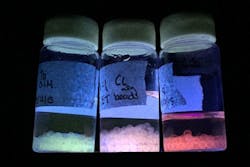MIT moves forward in project to develop biological materials for advanced military sensors
Officials of the U.S. Defense Advanced Research Projects Agency (DARPA) in Arlington, Va., announced an $8.2 million contract modification to MIT last week for the second phase of the Living Foundries: 1000 Molecules project to develop a biology-engineering infrastructure for the U.S. Department of Defense (DOD) and for the engineering biology community.
The DARPA program seeks to create a first-of-its-kind infrastructure comprising tools and processes that to help with innovation across several applications, and to help push biotechnology forward. The infrastructure will include design algorithms, genetic integration methodologies, and flexible assay systems.
MIT originally won an $11.1 million contract in May 2015 for the first phase of the DARPA 1000 project. MIT is in the process of producing at least 350 unique molecules to augment the Pentagon's limited set of chemical building blocks.
Related: DARPA works with six organizations on biological materials for military applications
Other organizations involved in the first phase of the DARPA 1000 project are Zymergen Inc. in Emeryville, Calif.; Amyris Inc. in Emeryville, Calif.; University of Texas-Austin in Austin, Texas; Duke University in Durham, N.C.; 20n Labs Inc. in San Francisco; and University of Illinois in Urbana, Ill.
Biologically produced molecules are more useful than traditional approaches for military applications in sensing chemicals, materials, and therapeutics, DARPA researchers say.
The rapid design and prototyping infrastructure should bridge the gap from initial, laboratory-level, proof-of-concept experimentation to industrial pilot production.
Key technical components will include computers to link component technologies; design tools to engineer novel biosynthetic pathways, gene cluster discovery, and chemical structure prediction; methods for automated construction of genetic designs; design evaluation tools to enable massively parallel testing, analysis, validation, and verification of engineered systems; and feedback tools with high-volume data generation.
Related: DARPA approaches industry for unmanned sensors to monitor Arctic land, sea, and air traffic
Ultimately, rapid design and prototyping facilities should consist of computational and physical infrastructure supporting design, fabrication, validation and quality control, and analysis, the totality of which should be tightly coupled to algorithms for design and processing.
DARPA 1000 has three challenge areas: rapid, improved prototyping of known molecules; prototyping of known, but currently inaccessible, molecules; and prototyping of novel molecules.
On this contract MIT will do the work in Cambridge, Mass.; Boston; Evanston, Ill.; and San Francisco, and should be finished by March 2018. For more information contact the Massachusetts Institute of Technology online at http://web.mit.edu/research, or DARPA at www.darpa.mil/program/living-foundries.
Learn more: search the Aerospace & Defense Buyer's Guide for companies, new products, press releases, and videos
